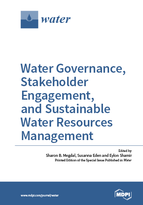Water Governance, Stakeholder Engagement, and Sustainable Water Resources Management
A special issue of Water (ISSN 2073-4441). This special issue belongs to the section "Water Resources Management, Policy and Governance".
Deadline for manuscript submissions: closed (20 February 2016) | Viewed by 208332
Special Issue Editors
Interests: water resources policy and management; negotiated decision making; the role of science in policy and decisions; groundwater recharge and recovery; sustainability and growth; climate change
Interests: comparative evaluation of water management; policy and governance in water-scarce regions; groundwater recharge; and transboundary aquifer assessment
Special Issues, Collections and Topics in MDPI journals
Interests: hydrologic modeling; flood forecasting; application of remotely-sensed data in flow forecasting; effect of climate variability on the hydrologic cycle and stochastic hydrology; risk assessment of water resources
Special Issue Information
Dear Colleagues,
This Special Issue of Water will focus on the relationship of water governance practices and stakeholder engagement approaches to the development, evaluation, and adoption of solutions to water management challenges. It is well recognized that the human dimensions of considering alternative water management scenarios and policy options are as least as important as their engineering, hydrological, and financial aspects. Identifying good governance practices and successful stakeholder engagement approaches can assist decision makers and water managers as they grapple with meeting the multiple environmental, economic, and societal objectives associated with sustainable water management. Papers are solicited that connect governance and/or stakeholder engagement approaches to the identification, characterization, and/or adoption of sustainable water management strategies, including conservation focused, flood risk reduction and technological solutions. The Guest Editors will consider papers addressing water governance and stakeholder engagement at all geographic scales, including transboundary. Papers addressing surface water, groundwater, and/or integrated water resources management are of interest, as are papers that examine indicators for governance and stakeholder engagement practices.
Prof. Dr. Sharon B. Megdal
Dr. Susanna Eden
Dr. Eylon Shamir
Guest Editors
Manuscript Submission Information
Manuscripts should be submitted online at www.mdpi.com by registering and logging in to this website. Once you are registered, click here to go to the submission form. Manuscripts can be submitted until the deadline. All submissions that pass pre-check are peer-reviewed. Accepted papers will be published continuously in the journal (as soon as accepted) and will be listed together on the special issue website. Research articles, review articles as well as short communications are invited. For planned papers, a title and short abstract (about 100 words) can be sent to the Editorial Office for announcement on this website.
Submitted manuscripts should not have been published previously, nor be under consideration for publication elsewhere (except conference proceedings papers). All manuscripts are thoroughly refereed through a single-blind peer-review process. A guide for authors and other relevant information for submission of manuscripts is available on the Instructions for Authors page. Water is an international peer-reviewed open access semimonthly journal published by MDPI.
Please visit the Instructions for Authors page before submitting a manuscript. The Article Processing Charge (APC) for publication in this open access journal is 2600 CHF (Swiss Francs). Submitted papers should be well formatted and use good English. Authors may use MDPI's English editing service prior to publication or during author revisions.
Keywords
- water governance
- stakeholder engagement
- sustainable water management
- surface water
- groundwater
- water solutions







